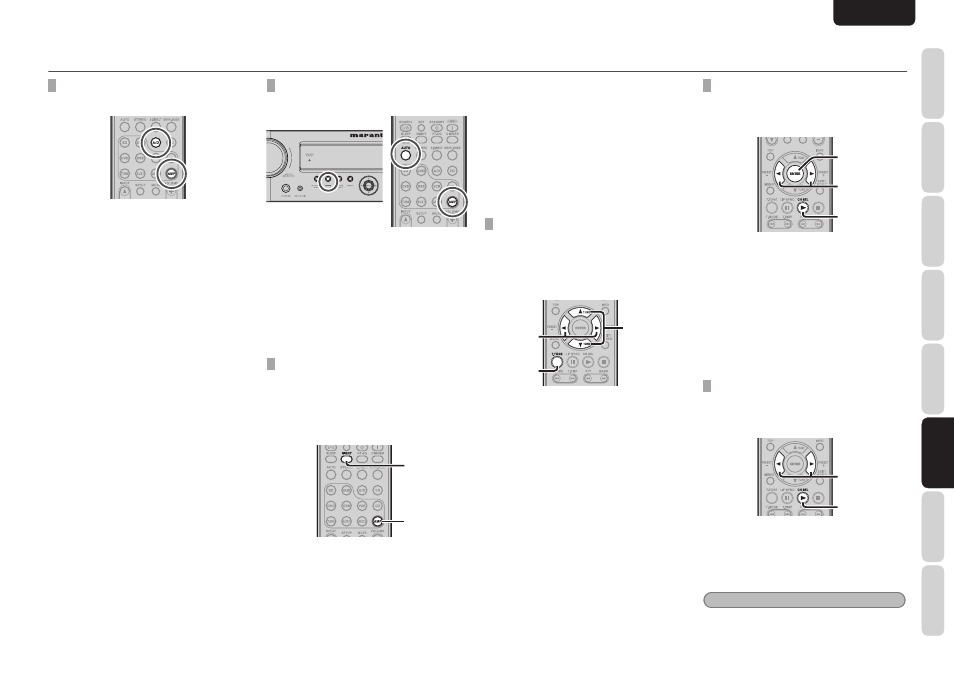Marantz NR1501 User Manual
Page 31

NAMES AND
FUNCTIONS
27
BASIC
CONNECTIONS
BASIC
OPERA
TION
ADV
ANCED
CONNECTIONS
SETUP
ADV
ANCED
OPERA
TION
TROUBLESHOOTING
OTHERS
ADV
ANCED
OPERA
TION
ENGLISH
SELECTING ANALOG AUDIO INPUT OR
DIGITAL AUDIO INPUT
If you have already assigned the digital inputs, you
can temporarily select the audio input mode for
each input source as following procedures.
Press the AMP button and press the A/D button.
When this button is pressed, the input mode is
switched in the following sequence.
Auto
→ HDMI → Digital → Analog → Auto
Auto mode:
The types of signals being input to the digital and
analog input jacks for the selected input source are
detected automatically.
If no digital signal is being input, the analog input
jacks are selected automatically.
HDMI mode:
HDMI mode can be selected only when an HDMI
input has been assigned as an input source.
When “HDMI AUDIO” under PREFERENCE of the
SETUP MENU is set to “THROUGH”, the HDMI
mode cannot be selected.
Digital mode:
The input signal is fi xed to an assigned digital input
terminal.
Analog mode:
The analog input jacks are selected.
ADVANCED OPERATION
SELECTING THE SURROUND MODE
example: AUTO SURROUND
(Using the unit)
To select the Auto surround mode during playback,
press the AUTO button on the front panel.
(Using the remote controller)
To select the Auto surround mode, press the AMP
button and press the AUTO button.
• For surround modes, see “Surround Mode” on
page 38.
NIGHT MODE
In the NIGHT mode, the dynamic range of the sound
played is reduced, making it possible to listen more
clearly to a softer sound while keeping the overall
volume level relatively low at night or in similar
circumstances.
This mode works only with Dolby digital sound.
2.
1.
1.
Press the AMP button on the remote
controller.
2.
Each time the NIGHT button is pressed, the
NIGHT mode value changes as below.
AUTO
→ 0.0 → 0.1 → 0.2 → ...... → 1.0 →
AUTO
The value represents the dynamic range
level.
• When the NIGHT mode is set to 0.0, it is deactivated;
when set to 1.0, it is at the maximum.
• When the NIGHT mode is set to AUTO, the signals
contained in the Dolby TrueHD software are
detected, and the NIGHT mode is automatically
activated.
• The NIGHT mode is deactivated with any Dolby
digital sound signals which are not Dolby TrueHD
signals.
• When the SOURCE DIRECT mode has been
selected, the NIGHT mode is deactivated.
ADJUSTING THE DIFFERENCE IN THE
VOLUME LEVELS BETWEEN SPEAKERS
(WITH TEST TONES)
Test tones can be output from each speaker,
and any difference in the volume levels between
speakers can be adjusted.
3.
2.
1.
1.
Press the T.TONE button on the remote
controller.
The test tones are output for 2 seconds each for
each channel in the following sequence which
is repeated: Front left
→ center → front right →
surround right
→ surround back right → surround
back left
→ surround left → subwoofer → front
left ...
• The test tone will not be output for a speaker
if NO has been set for that speaker on the
SPEAKER CONFIG menu.
2.
Press the
1/2 cursor buttons to adjust the
volume level of the speaker.
3.
Press the
3/4 cursor buttons to select
the speaker from which to output the test
tone.
4.
Repeat steps
2 and 3, and adjust the
volume level of the test tone that is output
from each speaker until the level for all the
speakers is the same.
REGISTERING THE SPEAKER VOLUME
LEVEL SETTING
Up to two volume levels that have been set as
desired can be stored in the memory.
2.
4.
3.
1.
1.
Press the CH SEL button on the remote
controller.
2.
Press the ENTER button.
“REF-1” blinks for several seconds on the
monitor and display.
3.
Press the
1/2 cursor buttons to switch the
storage location from REF1 to REF2 or vice
versa, and press the ENTER button.
4.
Press the ENTER button to store the current
volume level setting.
CALLING REGISTERED SPEAKER VOLUME
LEVEL SETTINGS
The volume level settings that have been registered
can be called.
2.
1.
1.
Press the CH SEL button on the remote
controller.
2.
Each time the
1/2 cursor buttons are
pressed, the volume level setting is
switched between AUTO, REF1 and REF2.
Tip
• When AUTO is selected, the speaker level that was
set automatically by AUTO SETUP is called.
For details on AUTO SETUP, see page 22.
